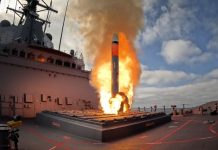China has called upon Japan to reflect on and learn from its history, an unusual reference to Japanese Imperialism and aggression during the Second World War, while fiercely opposing a potential transfer of second-hand Japanese Abukuma-class destroyers to the Philippines.
Japan has been considering the transfer of second-hand Maritime Self-Defense Force (JMSDF) Abukuma-class destroyer escorts to the Philippines, marking its first such transfer of naval vessels in decades.
The potential export was confirmed by the Philippines Navy, which stated that the navy personnel are preparing to perform a “joint visual inspection” of the 109-meter-long vessels after receiving an invitation from Japan’s Defense Ministry.
Philippine Navy spokesperson Capt. John Percie Alcos earlier said this would be a part of “exploratory discussions” over the potential transfer of these ships, indicating that the discussions are currently in a preliminary stage.
The transfer is aimed at deterring China, which claims almost the entire South China Sea as its sovereign territory and has overlapping territorial claims with Southeast Asian countries, including the Philippines.
The Chinese Coast Guard (CCG) regularly carries out aggressive maneuvers against the Philippines, with which it has multiple active territorial disputes in the region.
China’s Fierce Opposition
Unsurprisingly, China has taken a stern view of this potential transfer of used Japanese vessels. In a coldly worded statement, Chinese Defense Ministry spokesperson Jiang Bin on July 14 urged Japan to deeply reflect on and learn from history, and exercise caution in its words and deeds in the military and security fields, state-owned Global Times reported.
However, in an unwarranted move, the Chinese state media drew parallels between Japan’s export of equipment to regional countries and its actions during the World War era.
During World War II, Japanese militarism committed aggression and colonial rule against neighboring countries, including China and the Philippines, and occupied islands in the South China Sea, bearing grave historical responsibility. In recent years, Japan has breached the pacifist constitution and exclusively defense-oriented policy, continuously exporting weapons and equipment abroad in an attempt to form “small cliques” to disrupt the South China Sea and create instability in the Asia-Pacific region,” reads an excerpt from the Global Times report.
We urge Japan to deeply reflect on and learn from history, exercise caution in its words and deeds in the military and security fields, noted Jiang Bin, a Chinese Defense Ministry spokesperson on Monday, in response to Japan’s plan to export six used navy destroyers to the… pic.twitter.com/6OwFZsdtEo
— Global Times (@globaltimesnews) July 14, 2025
The comparison between Japanese Imperialism and its atrocities in China during World War II, and the recent effort at military modernization undertaken by the Japanese government to bolster its combat capability in response to rising regional security threats, appears to be misplaced.
Japan has maintained that its adoption of a relatively offensive posture is aimed at countering a persistent security threat from China, Russia, and North Korea.
China’s mention of the WW2 atrocities committed by the Imperialist Japan comes as the country is gearing to celebrate the 80th anniversary of the victory in the “Chinese People’s War of Resistance against Japanese Aggression and the World Anti-Fascist War,” in September 2025.
Earlier, reporting on the potential export of Japanese vessels to the Philippines, Chinese experts had accused the United States of encouraging the strengthening of defense ties between Tokyo and Manila to support the American Indo-Pacific strategy that seeks to contain China’s influence in the region.
Zhang Junshe, a Chinese military affairs expert, also added that Japan is attempting to alleviate the pressure it faces from China’s countermeasures regarding the disputed Senkaku Islands by selling weapons and equipment to the Philippines.
Old Japanese Destroyers For The Philippines Navy
Abukuma-class destroyer escorts, in service with the Japan Maritime Self-Defense Force for over 30 years, are set to be decommissioned by 2027 and replaced by newer Mogami-class frigates.
Thus, setting the stage for their export to a regional partner that could benefit from these aging but capable naval platforms.
Japan has historically restricted arms exports under its pacifist constitution, which renounces war and the use of force. However, it loosened these regulations in 2014 when it embraced the “Three Principles on Transfer of Defense Equipment and Technology.”
These guidelines permit the export of defensive equipment under certain restrictions, such as when it helps in global peace and security or Japan’s national interests, and only if the recipient government has strong export regulations in place.
However, Japan is getting around these limitations in the case of the Abukuma-class destroyer escorts by presenting the transfer as a joint development project, which complies with the principles and permits equipment upgrades. It will potentially overhaul the ships and upgrade them with modern systems suited to the Philippines’ needs.
The Philippines, on its part, has acquired second-hand naval platforms from other countries (like the South Korean Pohang-class vessels) in the past, all to boost its naval combat power and deter China in the disputed South China Sea.
The acquisition of these ships from Japan would be in line with Manila’s strategy, which would help bridge a sizable capability gap with China. Moreover, the Filipino military is no stranger to Japanese military equipment, having acquired its air surveillance radars and surveillance vessels in the past.

The 2,000-ton displacement Abukuma-class destroyers are outfitted with a 20mm close-in armament system, a 76mm cannon, and anti-submarine and anti-ship missiles. The Philippines will be better equipped to patrol and protect its territorial waters with these assets, especially in the disputed South China Sea.
The anti-submarine capabilities of these destroyers, including torpedoes and sonar systems, will improve the Philippines Navy’s capability to detect and counter potential submarine threats.
The Abukuma class vessels were among the first to use stealth characteristics like slanted hulls to reduce radar visibility.
Since the transfer includes upgrades to equipment and communication systems, it would likely foster interoperability with Japan. Additionally, as second-hand vessels, the Abukuma-class destroyers would be a cost-effective way to modernize the Philippine Navy, which has historically relied on archaic ships.
Some experts believe that the destroyers might have a serviceable life of about 10-20 years with adequate maintenance and upgrades. However, they also caution that the Philippines Navy would have to conduct a careful assessment of maintenance costs, spare parts, and system upgrades. It would also require extensive training to operate these vessels, which might prompt the JMSDF to rely on industry partners.
This export, if agreed on, would come as Japan is looking to export its advanced Mogami-class vessels to Australia and positioning itself as an arms exporter in the Indo-Pacific.
- Contact the author at sakshi.tiwari9555 (at) gmail.com
- Follow EurAsian Times on Google News




